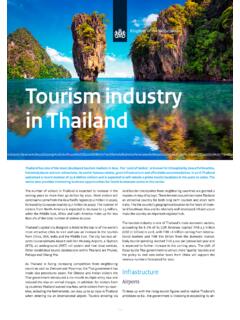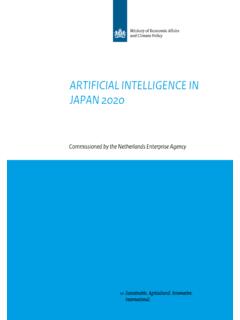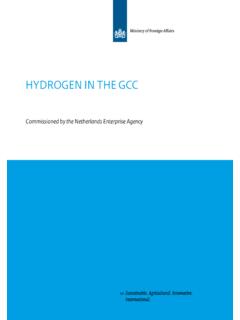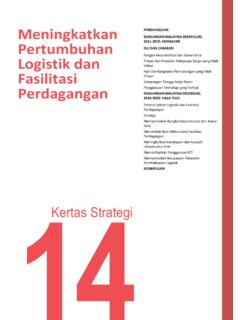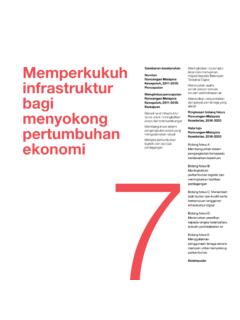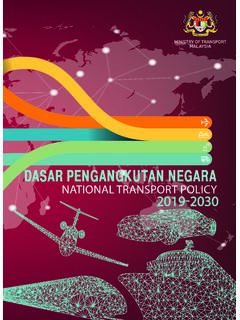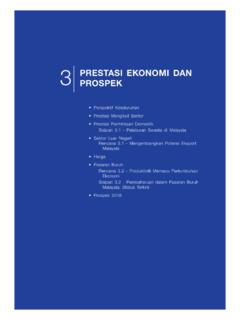Transcription of PORT DEVELOPMENT in MALAYSIA - RVO
1 PORT OF tanjung PELEPAS PORT DEVELOPMENT IN MALAYSIA AN INTRODUCTION TO THE COUNTRY S EVOLVING PORT LANDSCAPE i CONTENTS MARKET OPPORTUNITIES .. ii MARITIME GIANT MALAYSIA .. 2 GATEWAY TO SOUTHEAST ASIA .. 3 GLOBAL PORT ENVIRONMENT .. 4 PORTS OF MALAYSIA .. 5 MMC CORPORATION BERHAD .. 7 PORT POLICY .. 7 PORT KLANG .. 8 WESTPORTS .. 9 NORTHPORT .. 10 JOHOR PORT .. 11 PORT OF tanjung PELEPAS .. 12 JOHOR PORT AT PASIR GUDANG .. 13 PENANG PORT .. 14 BUTTERWORTH & PRAI WHARF .. 15 SWETTENHAM CRUISE PIER .. 15 BINTULU PORT .. 16 SABAH PORTS .. 17 OTHER PORTS .. 19 KUANTAN PORT .. 19 MALACCA PORT .. 19 KEMAMAN PORT .. 19 LABUAN PORT .. 19 SIPITANG .. 19 KUCHING .. 20 MIRI .. 20 20 PRIVATE PORTS .. 20 OFFSHORE SUPPLY .. 20 SHIPBUILDING .. 20 ii MARKET OPPORTUNITIESL arge, established port and maritime market. The vast size of the maritime and port industry generates a constant demand to tap on to for Dutch port and maritime service providers and technology suppliers, including all on dock cargo handling related activities, tugging, ship supply, maintenance and repair, as well as manufacturers of port related and cargo handling transport equipment, warehousing and other support activities for transportation.
2 Expanding container transhipment hub. As a large and expanding transhipment hub, MALAYSIA can greatly benefit from Dutch innovators in the field of container handling and terminal design as to increase efficiency and capacity both for existing and new terminals in a sustainable way. The prefered gateway to Southeast Asia. With affordable land available within free commercial zones around the major ports, MALAYSIA is an attractive location for Dutch companies to establish an regional distribution centre to serve the growing Southeast Asian market. Untapped market for smart port DEVELOPMENT . Malaysian ports need to innovate and modernize their operating facilities through digitalization and automation. There is much room for Dutch expertise to meet MALAYSIA s prioritized demand for smart-port DEVELOPMENT , including integrated port community systems and related digital solutions.
3 Huge scale port expansion and land DEVELOPMENT plans. With a broad range of port expansion and land DEVELOPMENT plans around the major ports and urban coastal centres, MALAYSIA is an interesting market for the Dutch port DEVELOPMENT industry with opportunities for dredgers, engineers, port operators, constructers, project developers, architects, consultants and investors. iii One of world s main palm oil exporters. A solid cargo base is generated by the oil palm, timber and other agricultural produce industries. In this regard, specialized Dutch port developers, industrial engineers and project developers can find a promising market for the construction and expansion of new small sized ports in Sabah and Sarawak. Oil & gas producing and trading hub. Demand for specialized (private) port facilities to serve the vast Malaysian oil & gas industry remains high, leaving a market for Dutch producers and suppliers of specialized industrial equipment, machinery and services in this industry.
4 Offshore supply & maintenance base. MALAYSIA serves the large offshore industry through its ports on the east coast. Dutch offshore equipment suppliers, constructors and transporters can remain an important player in this market. Growing cruise destination. As a popular tourist destination surrounded by sea, global rise in cruise tourism will spark demand for extended cruise ports in MALAYSIA . Dutch cruise supporting businesses can help MALAYSIA to accommodate the increase in cruise calls. 2 MARITIME GIANT MALAYSIAThe rapid growth and DEVELOPMENT of the Malaysian economy over the past decades cannot be seen a part from the country s location alongside world s most important trade routes. The Straits of Malacca have been a strategic waterway in global trade for centuries.
5 Today that is no different. MALAYSIA is a real maritime nation and home to some of the world s largest to the United Nations Conference on Trade and DEVELOPMENT (UNCTAD), MALAYSIA is the world s fifth best connected country in terms of shipping line connectivity, ahead of the Netherlands and the United States. MALAYSIA is a container transhipment hub in the region and a market leader in handling and exporting oil and gas products. Over the last ten years Malaysian ports have recorded an average growth of 3% in compound cargo throughput. Following a drop in 2017 due to a change in the shipping line market and overall lows in global seaborne trade, cargo throughput recovered in 2018 totalling at 568 million tonnes. About 70% of the cargo is containerized.
6 With a total throughput of million TEUs in 2018, Malaysian ports handled almost as many containers as the ports of Rotterdam and Antwerp combined. While the majority is transhipment, cargo that does not enter the country, Malaysian exports and imports accounted for respectively and million TEUs in throughput. Last but not least, as one of world s largest liquefied natural gas (LNG) exporters, MALAYSIA is home to the first floating LNG port facility and the largest palm oil terminal in the world. UNCTAD MARITIME CONNECTIVITY INDEX Best connected countries and/or territories1. China2. Singapore3. Korea, Hong Kong (China)5. Malaysia6. Netherlands7. Germany8. United States9. United Kingdom10. Belgium395450498501511542570569545568010 0200300400500600700 TREND IN CARGO THROUGHPUT BY MALAYSIAN PORTS(million tonnes)Cargo throughput18%17%65% MILLION TEUS IN 2018exportimporttransshipment 3 GATEWAY TO SOUTHEAST ASIA The strategic location and good connectivity make MALAYSIA one of the preferred countries to enter the Southeast Asian market.
7 Over the last decades MALAYSIA saw an impressive increase in container traffic through its ports, leaving behind other emerging economies in the region. Since 2000 MALAYSIA recorded a 400% growth in container throughput, now taking up almost a quarter of all containers handled in the region. Twenty years ago thi s was still 10%. This is no surprise. MALAYSIA is right at the heart of the region where intercontinental and intra-Asian sea trade routes meet each other. Singapore remains the leading port in the region, but has little space to expand and fewer connections over land. With plenty of affordable land available, well maintained infrastructure and a flourishing economy, MALAYSIA will only strengthen its already strong position as the doorstep of the region, and benefit from rising container traffic in Southeast CONTAINER THROUGHPUT BY PORTS IN SELECTED SOUTHEAST ASIAN COUNTRIES (million TEUs)SingaporeMalaysiaIndonesiaVietnamTh ailandPhilippinesSOURCE: THE WORLD BANK GROUP 4 GLOBAL PORT ENVIRONMENT Global seaborne trade increased by 4% in 2017, the fasted growth in five years.
8 It is estimated that this trend has continued into 2018 with UNCTAD forecasting a compound annual growth of until 2023. Global economic and geo-political developments cause both challenges and opportunities for the Malaysian maritime and port sector. Yet it is expected that Southeast Asia will remain a promising market with increasing interests from (overseas) investors and manufactories, sparking growth in flows of goods, expanding trade and keeping up demand for port activity and expansion. The role of China A global rise in protectionism and reoccurring trade disputes between China and the United Stated (US) might temper growth in Chinese exports to the West, which can have its effect on seaborne trade and the transhipment function of MALAYSIA . However, now that labour costs in China are rising and Beijing is forced to focus more and more on feeding and serving its domestic market, export manufactories are looking elsewhere and often move activities to Vietnam, MALAYSIA , Indonesia and Thailand.
9 With its comprehensive and well maintained infrastructure, relatively low labour costs, English speaking workforce and affordable land available, MALAYSIA might well be the first choice in the region for foreign businesses to settle. Likewise, China itself has increased interest in MALAYSIA and is doing major investments in infrastructure projects through its global DEVELOPMENT strategy known as the belt-and-road initiative (BRI). On the east coast of Peninsular MALAYSIA , facing the South China Sea, port DEVELOPMENT is mainly incited by Chinese investment. Shipping line alliances Following the reshuffle of alliances in 2016, MALAYSIA saw a substantial drop in cargo throughput. Consolidation of shipping lines into major alliances increases their bargaining power when negotiation port calls and terminal operations.
10 In combination with the ever growing vessel size and the tendency to concentrate activities in several large ports along the main trading routes, it is a trend that is expected to continue and form a serious challenge for the fragmented Malaysian port landscape. Decisions of the liner shipping alliances can make or break the financial year of a port. Yet, the same counts for competing ports in the region. With the right investments and a strategy that recognizes this developments, the established ports of choice in the region can be challenged as well. Modernization & Digitalization As in any industry, ports are required to implement advanced technologies, digitalize processes and adopt innovative working methods to improve efficiency, reduce costs and therefore stay ahead of competitors.


